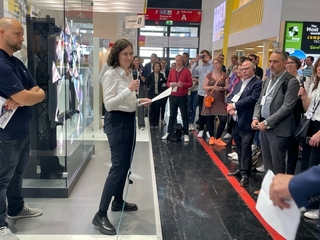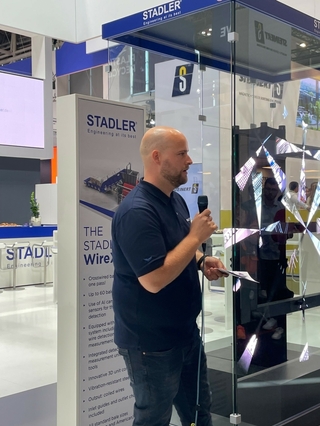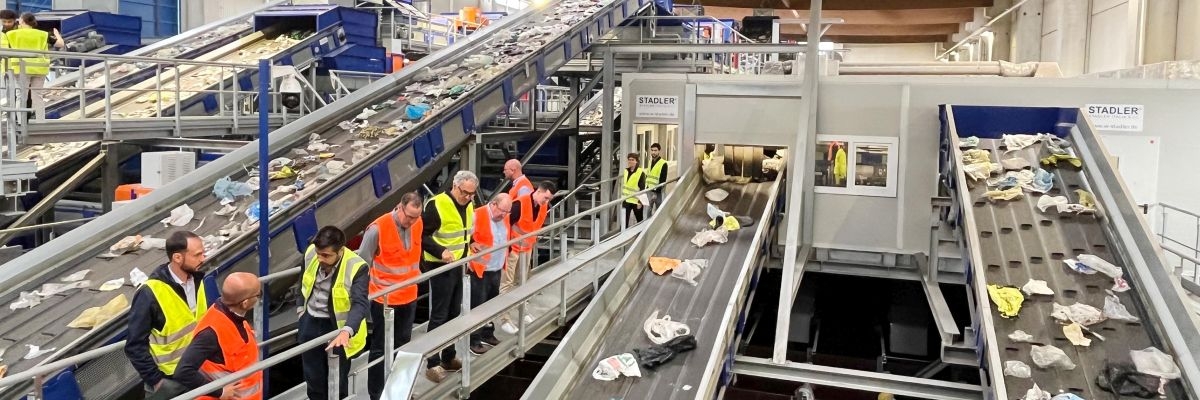STADLER outlines strategy for the future and unveils latest innovations at IFAT 2024
17.05.2024STADLER Anlagenbau GmbH, the globally active German company specializing in the planning, production and assembly of turnkey recycling and sorting plants, presented its strategic objectives and unveiled its groundbreaking WireX automated bale wire remover and innovative digital solutions during a press conference held on May 13 at the IFAT trade fair in Munich, Germany. As part of its strategy to secure STADLER’s future in the long term, the company appointed Julia Stadler as Chief Digital Officer in 2023, the first member of the eighth generation in the family business.
 From left: Julia Stadler, Chief Digital Officer with Rok Mežič, Head of Development and CEO Willi Stadler
From left: Julia Stadler, Chief Digital Officer with Rok Mežič, Head of Development and CEO Willi Stadler
© STADLER Anlagenbau GmbH
Willi Stadler, CEO, and Julia Stadler led the press conference, outlining the company’s short to medium-term strategy, which focuses on advancing the Circular Economy, harnessing digital solutions, and pursuing its research programme in its constant search for new ways of supporting the recycling industry in its evolution.
Towards a circular economy: collaboration across the value chain
The growing environmental awareness across governments, corporations and consumers is driving progress towards a circular economy, which is gaining momentum. New regulations are continuously coming into force to foster sustainable practices – from addressing the issue of single-use plastics to incentivising recycling. Technological advances are constantly expanding the scope of recycling and reducing our reliance on virgin plastics. Corporate reputation and potential cost savings are increasingly pushing companies to commit to circular economy principles.
 During the press conference at the booth of STADLER Anlagenbau GmbH
During the press conference at the booth of STADLER Anlagenbau GmbH
© STADLER Anlagenbau GmbH
“We can see that the world is going in the right direction,” says Willi Stadler. “However, we still face important challenges such as economic viability, product design complexity and the need for global standards and cooperation. At STADLER, we believe that effective collaboration of all the members of the value chain is essential for further progress towards a circular economy to be made. This means the involvement and coordination of industry associations, authorities at local and government level, the European Commission, research institutes and universities, designers and users of products and packaging, all the way to the recycling industry and suppliers of sorting plants and technologies like STADLER.”
“As a plant and equipment manufacturer, our primary role in the chain is to support the recycling industry with our high-performance sorting systems,” adds Julia Stadler. “We are constantly searching for new ways to help the recycling industry expand its scope and effectiveness. To this end, in addition to our in-house research programmes, we participate in research projects to explore solutions to recycle more materials from different waste streams. Also, we believe that we can make a big difference by acting as a link between key elements of the value chain.”
Harnessing digital technologies to advance the circular economy
 Julia Stadler, Chief Digital Officer
Julia Stadler, Chief Digital Officer
© STADLER Anlagenbau GmbH
Digitalization is playing an increasingly significant role in industry and is a strategic priority for STADLER. “The trajectory is clear,” explains Julia Stadler. “The future will increasingly involve harnessing machine and material data to minimize plant downtime, reduce costs for recyclers and increase process transparency, ultimately leading to a more efficient industry. At STADLER we have focused on developing and prioritizing digital solutions that deliver substantial value for our customers. We have already successfully implemented digital solutions for dynamic plant control, maintenance, and visualization of production data across various customer sites. We run an ongoing development program, testing prototypes at our Test Center and at customer facilities to ensure the efficacy and adaptability of our technologies.”
STADLER is planning to increase its investment in digital technologies in the short and medium term: “Our strategy includes the integration of digital solutions consistently into our comprehensive offering, and driving our research forward,” says Julia Stadler. “We are currently working on a new, innovative platform, STADLER Connect, which will integrate all our digital solutions to provide a cohesive and streamlined user experience. With this platform, we aim to enhance connectivity and functionality, maximizing the benefits for our customers.”
 Among other things STADLER Anlagenbau GmbH presented its WireX automated bale wire remover
Among other things STADLER Anlagenbau GmbH presented its WireX automated bale wire remover
© STADLER Anlagenbau GmbH
STADLER is also exploring the potential of Artificial Intelligence (AI) in the recycling industry and has already applied it to improve the recognition of materials for quality analysis, as well as in the new WireX, where it is used to identify the direction of the wires. Julia Stadler explains: “Our future plans in this area are focused on enhancing our AI-based technologies while leveraging our existing solutions. To this end, we are collaborating with a select group of start-ups working in this field.”
“This strategic partnership approach allows us to integrate cutting-edge technologies without starting from scratch, ensuring we remain at the forefront of innovation in our industry,” concludes Willi Stadler.
An industry first: the new WireX
 Rok Mežič, Head of Development
Rok Mežič, Head of Development
© STADLER Anlagenbau GmbH
Center stage on STADLER’s booth at IFAT was a holographic display of its latest innovation, the WireX an automated dewiring unit for bales. At the press conference, Rok Mežič, Head of Development at STADLER, explained how this machine is capable of dewiring crosswired bales in a single pass – an industry first: “The WireX uses specially designed wire detection and bale measurement systems, which rely on AI and sensor technology to determine if the bale is single- or double-wired and to position it precisely to remove the wire efficiently in one pass. This fully automates and speeds up the dewiring process, achieving an outstanding capacity of up to 60 bales/h (single-wired). The WireX is fast, efficient and safe, and significantly increases the capacity of the sorting line.”




